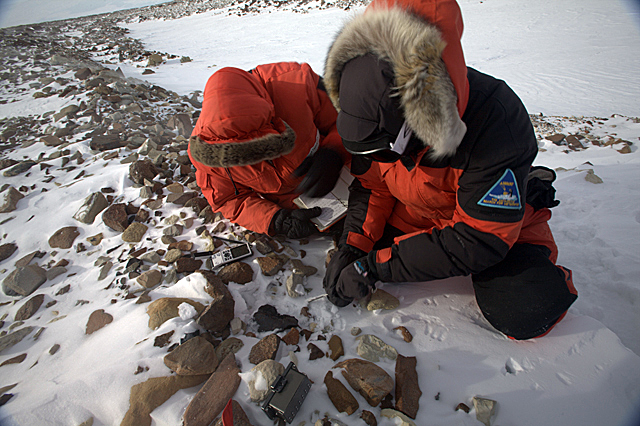Rocking scienceAntarctic meteorites offer insights into history of early solar systemPosted September 25, 2009
Field researchers in Antarctica have returned with more than 17,500 meteorites over the 30-plus years that the extraterrestrial material has been collected from the frozen continent. Yet meteorite science is still in its infancy, and the collected rocks still hold plenty of surprises that could shape our understanding of the solar system, according to scientists involved in the search and characterization of the Antarctic meteorite collection. More on Meteorites
Sidebar: Meteorites in the field
Pevious coverage: The Antarctic Sun, Jan. 8, 2006 The Antarctic Sun, Oct. 24, 2004 Ralph Harvey “It’s a young science in that respect. Any new specimen has the potential to shake the foundation of how these things are categorized. That’s why it’s still important to bring back more specimens,” explained Harvey, a researcher and professor at Case Western Reserve University A paper in the journal Nature earlier this year illustrates his point. Scientists who analyzed two meteorites collected by Harvey’s team during the 2006-07 field season in an area called the Graves Nunatak ice field reported that the rocks are unlike anything found before. The composition of the light-colored rocks has similarities to the Earth’s crust, which has implications for how some asteroids form and evolve. The more meteorite samples available, the greater the chance of such discoveries, said Kevin Righter, Antarctic meteorite curator at NASA’s Johnson Space Center Early speculation on their origin, he said, focused on planetary bodies like Venus or Jupiter’s moon Io. “A lot of people requested samples in case they turned out to be something interesting like that,” Righter said. “Figuring out the samples’ origin is an area of active research right now.” Making discoveries possibleSuch discoveries and research are possible thanks to the collaboration between the NSF, NASA and the Smithsonian Institution’s National Museum of Natural History 
Photo Credit: Tim McCoy
A thin section of a meteorite from the Miller Range, Antarctica, looks a bit like a stained glass window.
NSF funds the field research carried out by ANSMET each year. The field teams, composed of different members from the planetary science research community each year, find at least a few hundred samples each season, but have also collected more than 1,300 in a single season since they started. All those rocks, ranging in size from smaller than a marble to larger than a football, are bagged and boxed in Antarctica in their frozen state for shipment back to the United States. A cargo ship carries them from McMurdo Station The samples remain in a freezer until Righter and his team can process them. The curation team then thaws the rocks in a sterile dry nitrogen cabinet. The dry gas keeps the meteorites, which can contain metals and minerals, from rusting or from becoming contaminated. “A lot of meteorites contain iron metal. It can rust pretty quickly. That’s why we keep them frozen,” Righter said. The small staff in the NASA lab — part of the same facility used to house rocks from the Apollo moon missions — also photographs, weighs and describes each rock. The staff of the Smithsonian Institution makes the initial classification of the meteorites, most of which are stony chondrites. “The other stuff is what people really want to study,” noted Tim McCoy, curator of the Smithsonian’s Antarctic collection McCoy’s team at the Smithsonian receives a small piece of each meteorite — or the whole rock it if turns out to be an iron meteorite — for analysis that allows a classification of each sample. A thin section less than the width of a human hair is glued to a piece of glass, and then studied under an electron microscope, which can provide information on an area one millionth of a meter wide. Additional work by scientists in the community may involve isotopic analysis to help “fingerprint” the sample to determine its origin. For example, scientists can identify rare Martian rocks by analyzing the nitrogen and noble gases found in glass pockets in the rocks created by impacts. That information is matched against the data collected by NASA’s Viking program about Mars’ atmosphere. “After a while, you get used to what they look like and can pick them out pretty reliably,” McCoy said.1 2 Next |



For USAP Participants |
For The Public |
For Researchers and EducatorsContact UsU.S. National Science FoundationOffice of Polar Programs Geosciences Directorate 2415 Eisenhower Avenue, Suite W7100 Alexandria, VA 22314 Sign up for the NSF Office of Polar Programs newsletter and events. Feedback Form |


